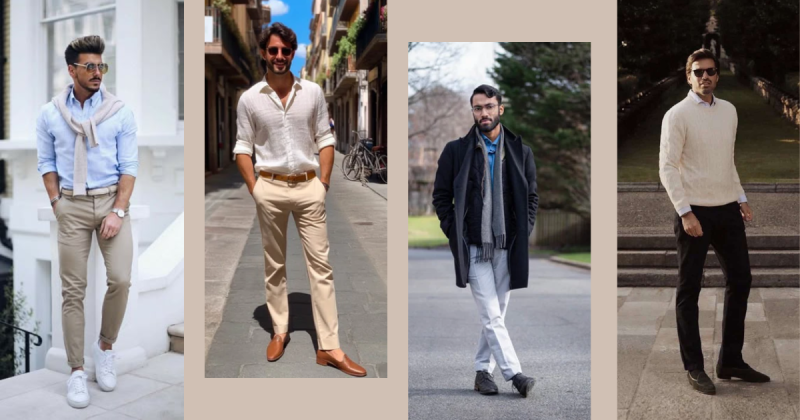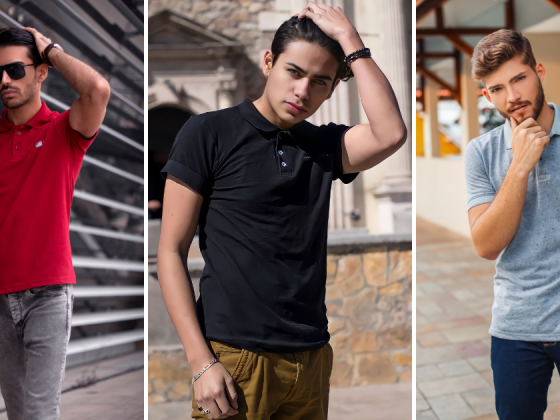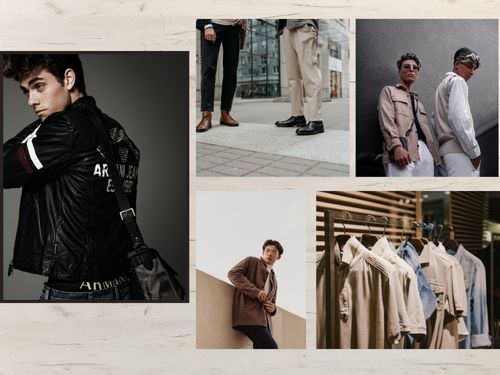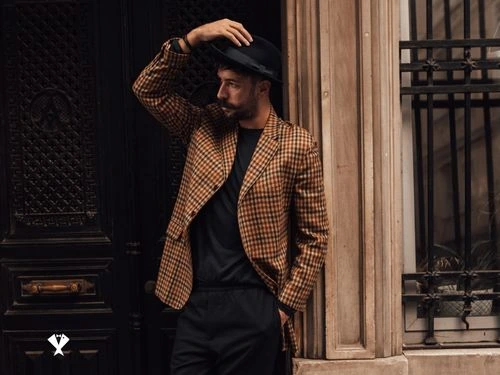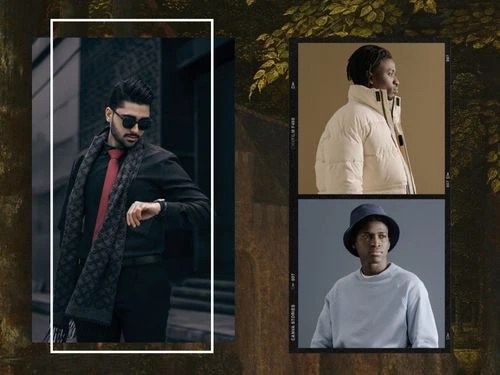Your silhouette is more than just the clothes you wear; it’s a powerful statement of your style. It’s the first thing people notice about your outfit—how your clothing shapes your body, highlights your proportions, and creates an overall impression. A silhouette in fashion refers to the outline or contour that clothing creates around the body, influencing how a person looks balanced, structured, and polished.
Understanding Your Body Type
The first step to enhancing your silhouette is understanding your body type. Clothing should complement your natural shape rather than work against it. Here’s a breakdown of the five primary male body types and how they influence styling choices:
- Rectangle Body Type: Men with a rectangular body shape usually have a slim, straight frame where their shoulders, waist, and hips are almost equal in width. With this naturally undefined silhouette, the key is to craft the visual impression of a more pronounced and structured upper frame. Opt for structured blazers, layered outfits, and horizontal patterns to add width to the shoulders.
- Triangle Body Type: This body type features a wider waist and hips in proportion to the shoulders. The key to balancing this shape is drawing attention upward. Avoid clothing that emphasizes the midsection and opt for jackets with structured shoulders, darker bottoms, and V-neck tops to create a more balanced silhouette.
- Inverted Triangle Body Type: Common among men who work out regularly, this body type features broad shoulders and a muscular chest that tapers down to a narrower waist and hips. While this shape is often desirable, an overly tight fit can exaggerate proportions too much. Opt for straight-leg trousers to add visual weight to the lower half and balance the silhouette.
- Oval Body Type: Men with this body type tend to have a rounded midsection with broader shoulders and chest. The aim is to extend the torso’s visual length, sculpting a sleek and uninterrupted silhouette. Vertical stripes, darker colors, and structured jackets help achieve this effect.
- Trapezoid Body Type: It is considered the “ideal” male body shape, with broad shoulders gradually narrowing down to the waist. Most clothing styles suit this shape well, but maintaining proportion and fit remains essential.
Core Principles for Silhouette Enhancement
- Fit is Paramount: Regardless of body type, wearing clothes that fit correctly is the most critical factor in achieving a well-defined silhouette. Whether baggy or tight, ill-fitting garments distort the body’s natural lines and can throw off proportions. Tailored clothing ensures a polished, put-together look.
- Proportion is Key: Maintaining balance is crucial. If your upper body is broad, avoid overly slim trousers that make your legs appear disproportionately small. Similarly, structured jackets and layering can add volume if you have a skinny upper body.
- Explore Different Silhouettes: Menswear doesn’t have to be confined to a single silhouette. Experimenting with different shapes, from slim fits to oversized proportions, allows for a more dynamic and unique approach to fashion. The key is knowing how to balance proportions for a cohesive look.
8 Approaches to Enhance Silhouette
1. Layering for Dimension
Stacking complementary pieces is a masterful technique to infuse dimension and captivate the eye with a dynamic style. You can create a more dynamic and structured look by combining different textures, colors, and fabrics. A well-layered outfit adds shape and structure, making the body appear more proportionate and visually balanced. For example, pairing a structured blazer over a turtleneck can define the shoulders, while a long coat elongates the body. Mid-layers, such as lightweight cardigans or vests, can enhance the outfit without adding bulk. Proper layering also allows for adaptability, ensuring you stay comfortable in varying temperatures while maintaining a stylish appearance. The key is to layer strategically, avoiding excessive bulk while achieving a refined and polished look.
2. Strategic Use of Color and Patterns
Shades and patterns are powerful tools in altering visual perception and sculpting body proportions. Vertical stripes elongate the frame, making them a go-to choice for oval or trapezoid shapes seeking added height. On the other hand, horizontal stripes broaden a lean physique, making them perfect for amplifying the upper body’s presence. Darker colors generally have a slimming effect, absorbing light and creating a more streamlined look. Lighter hues, however, can highlight areas you want to emphasize, bringing attention to specific body parts. Patterns like checks or plaids can add structure and dimension, depending on their scale and placement. Understanding the interplay of color and patterns can help create a well-balanced and intentional silhouette.
3. Tailoring and Alterations
A well-tailored garment can completely transform an outfit and elevate its overall appearance. Off-the-rack clothing rarely fits perfectly, so minor adjustments—like tapering trousers, adjusting sleeve lengths, or wearing a blazer—can refine your silhouette and ensure a flattering fit. Tailoring helps create clean lines, ensuring that garments drape correctly on your body without excess fabric or awkward bunching.
For instance, a suit jacket with a nipped-in waist creates a strong V-shape, accentuating the shoulders and chest. For a more customized fit, even casual pieces like jeans or t-shirts can benefit from minor alterations, such as hemming or tapering. Investing in professional tailoring can make even budget-friendly clothing appear high-end. The key is to focus on precise adjustments that enhance your natural proportions without restricting movement.
4. Choosing the Right Footwear
Footwear affects overall proportions more than people realize, influencing how an outfit is perceived. Chunky sneakers or boots can add visual weight to the lower half, making them ideal for balancing out broader upper bodies. Conversely, sleek dress shoes or loafers create a streamlined, elegant finish that works well for leaner frames. The height of a shoe’s sole can subtly alter your posture and stance, affecting the overall balance of your silhouette.
High-top sneakers and boots can elongate the legs with slim-fit pants, while low-cut shoes create a more grounded, relaxed look. Footwear color also plays a role—dark shoes can create a cohesive, elongated effect, while lighter tones add contrast and visual separation. Choosing the proper footwear ensures that your outfit remains harmonious and well-proportioned.
5. Accessorizing Strategically
Accessories can enhance your silhouette and bring attention to specific body areas. A wide belt can define the waist, creating a more structured and proportional look. Scarves or statement necklaces draw attention upward, emphasizing the neckline and face. Hats can also influence proportions—wider-brimmed styles can balance broader shoulders, while structured caps complement more angular features. Sunglasses can help frame the face and reinforce the overall aesthetic of an outfit. Watches, bracelets, and rings can add refinement and serve as subtle focal points without overpowering the look. Thoughtful accessorizing allows for creative expression while maintaining harmony in your overall silhouette.
6. Experimenting with Necklines
Different necklines create different effects and can significantly impact the proportions of an outfit. V-necks help elongate the neck and are flattering on men with broader upper bodies, creating a balanced visual effect. Crew necks add width to a slim frame, making them ideal for individuals who want to create the appearance of a fuller upper body. High necklines, like turtlenecks, create a sophisticated, streamlined silhouette that works well in casual and formal settings.
Boat necks and wide necklines can broaden the shoulders, while deeper necklines can create a relaxed, effortless aesthetic. Layering different necklines, such as wearing a collared shirt under a crew neck sweater, adds dimension and refinement. Understanding which neckline suits your body type allows you to make intentional choices that enhance your overall appearance.
7. Playing with Proportions
Fashion-forward brands like Rick Owens frequently play with exaggerated proportions to create striking silhouettes. Pairing oversized tops with fitted bottoms allows for creative expression while maintaining balance. The key is avoiding extremes—moderate contrasts work best for everyday wear, ensuring the outfit remains wearable and stylish. For example, an oversized sweater paired with tailored trousers creates a relaxed yet refined look. Cropped or tapered joggers can balance out a loose-fitting jacket, preventing the outfit from looking too bulky. Experimenting with different silhouettes lets you discover which proportions work best for your style. When done correctly, playing with proportions can make an outfit feel dynamic and fashion-forward without appearing forced.
8. Drawing Inspiration from High Fashion
High fashion often pushes the boundaries of menswear silhouettes, offering unique perspectives on proportion and structure. Observing designer collections can inspire fresh ways to experiment with shape, texture, and layering. Whether it’s structured tailoring from Thom Browne or draped, avant-garde pieces from Yohji Yamamoto, incorporating elements of high fashion into everyday style can make for a unique, well-crafted silhouette. While runway looks may be extreme, subtle adaptations—such as a slightly oversized blazer or asymmetric layering—can make a statement without overwhelming an outfit.
Monochrome styling, elongated hemlines, and unexpected fabric choices are all high-fashion influences that can translate into everyday wear. The goal is to refine inspiration to fit your aesthetic, making bold styling choices feel intentional rather than excessive. Learning from high fashion allows a more artistic and experimental approach to dressing while maintaining a polished, wearable appeal.
Mastering Your Silhouette with Confidence
Enhancing your silhouette goes beyond following trends—understanding your body type, experimenting with different approaches, and creating a balanced, visually appealing look. Focusing on fit, proportion, layering, and strategic styling allows you to refine your style while staying true to your individuality. Fashion is all about creativity and self-expression—embrace the freedom to experiment with bold shapes, explore fresh styles, and fine-tune your wardrobe confidently. The key to a great silhouette isn’t just about looking good—it’s about feeling confident in presenting yourself to the world.
